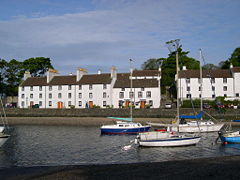Cramond
Cramond
|
|
|---|---|
 Cramond Harbour |
|
| Population | 7,502 (2001) |
| Council area | |
| Country | Scotland |
| Sovereign state | United Kingdom |
| Post town | EDINBURGH |
| Postcode district | EH4 |
| Dialling code | 0131 |
| Police | Scottish |
| Fire | Scottish |
| Ambulance | Scottish |
| EU Parliament | Scotland |
| UK Parliament | |
| Scottish Parliament | |
Cramond (/ˈkræmənd/; Scottish Gaelic: Cathair Amain) is a village and suburb in the north-west of Edinburgh, Scotland, at the mouth of the River Almond where it enters the Firth of Forth.
The Cramond area has a long history, with evidence of Mesolithic, Bronze Age and Roman activity. In modern times, it was the birthplace of the Scottish economist John Law (1671–1729). Cramond was incorporated into the City of Edinburgh by Act of Parliament in 1920.
It was once believed that Cramond Roman Fort was known to the Romans as Alaterva. A stone altar was dug up in the grounds of Cramond House dedicated "To the Alatervan Mothers and the Mothers of the Parade-ground." Early antiquarians interpreted the inscription as referring to the place where the stone was found, but this idea is no longer accepted among scholars, and "Alatervae" is presumably a native name for the Matronae, perhaps originating with the Tungrian cohort who erected the altar.
In the centuries that followed the end of the Roman occupation, Cramond passed into the hands of the Votadini, who spoke Cumbric, a Brythonic Celtic language, and gave the settlement its name. Cramond is derived from the compound Caer Amon, meaning 'fort on the river', referring to the Roman fort that lay on the River Almond.
...
Wikipedia
